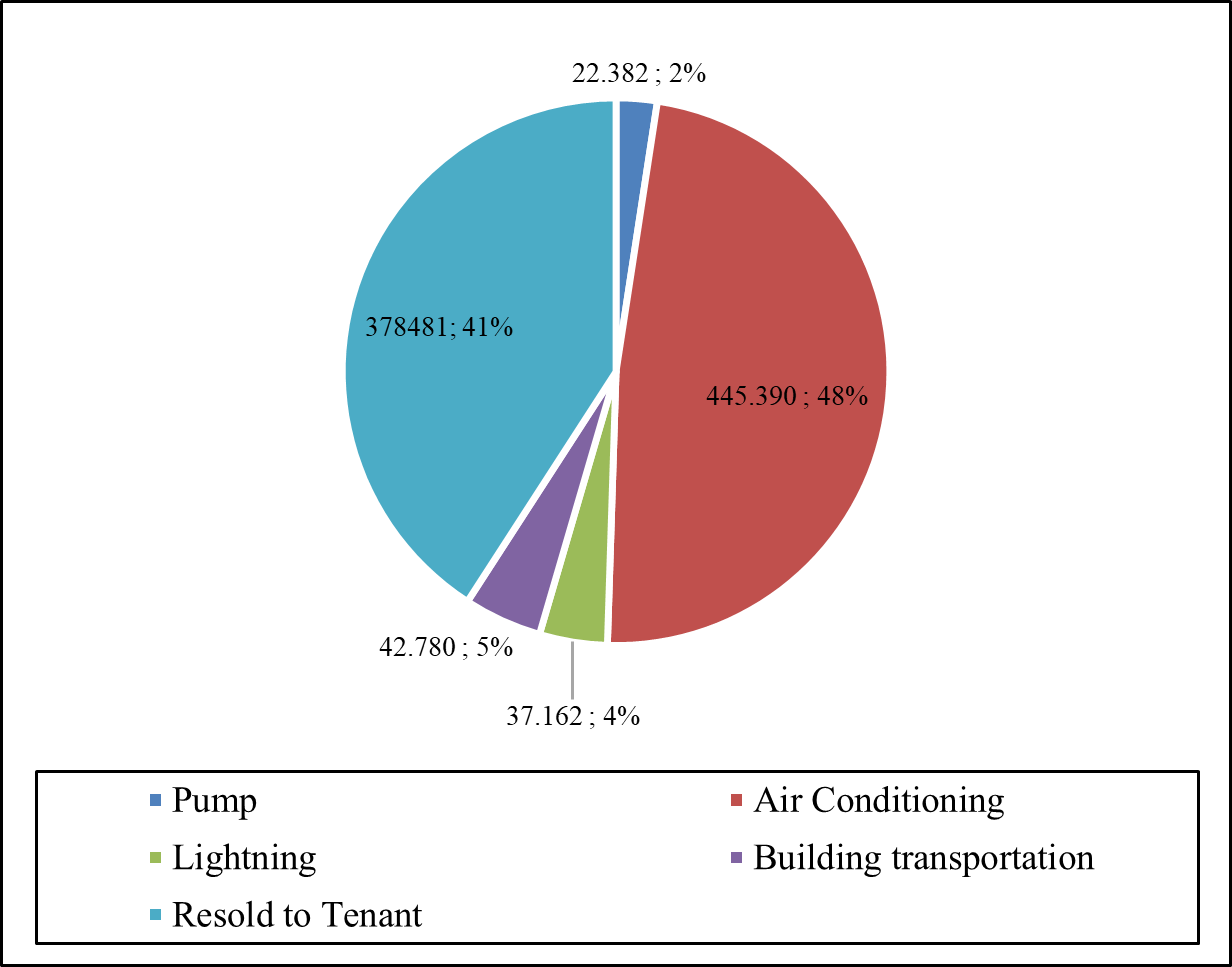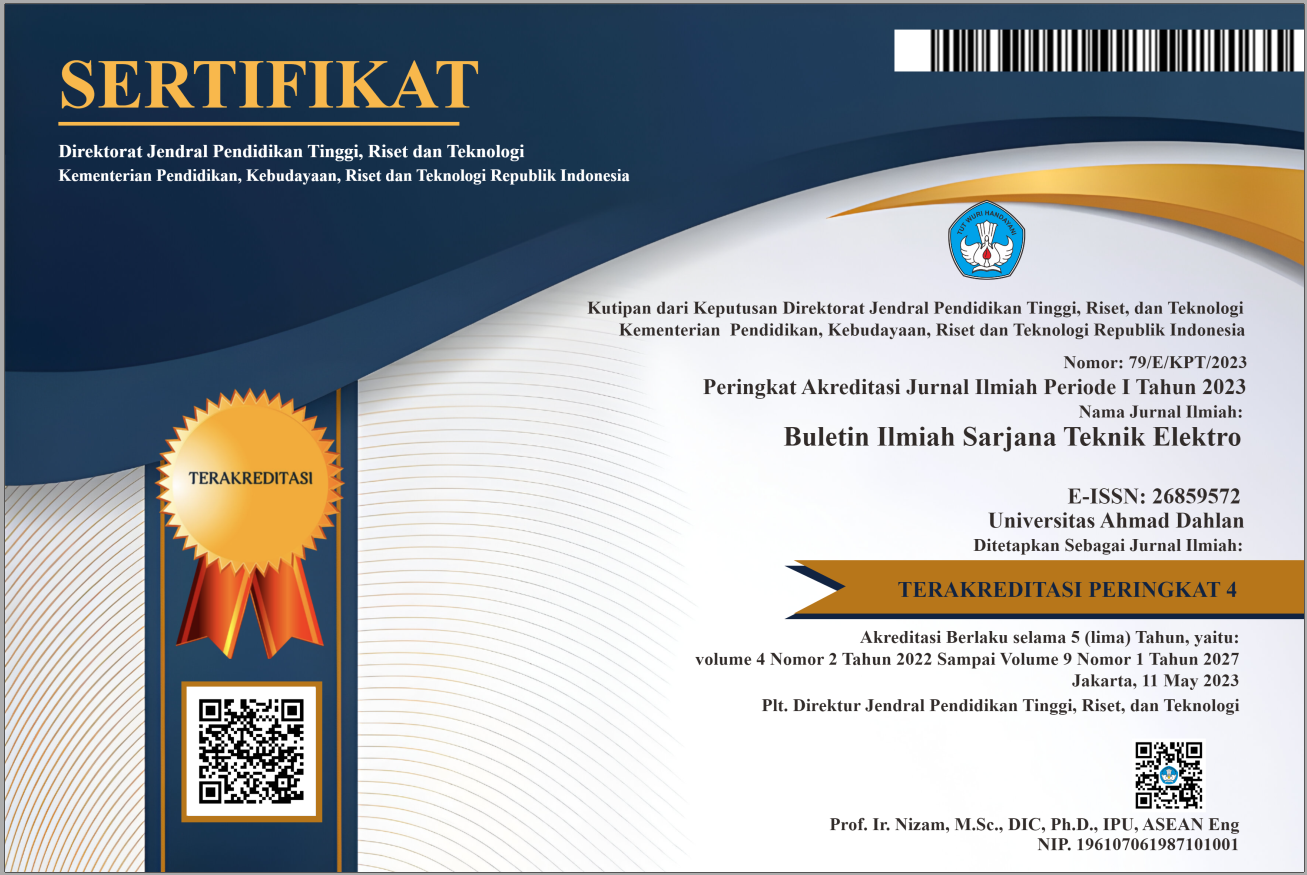A Novel of Energy Consumption Profile of a Shopping Center
DOI:
https://doi.org/10.12928/biste.v5i4.9230Keywords:
Energy Conservation, Audit Energy, SNI: 03-0196, Energy Consumption Index, Profile EnergyAbstract
Energy conservation in Indonesia is the primary choice made by the government of the Republic of Indonesia. It is undeniable that the highest consumption of a building is air conditioning energy, especially in a tropical environment like Indonesia. Air conditioning consumes between 40% and 80% of power in a high-rise building. The problem is how to find out the electricity usage profile and energy consumption index in a building that has been in operation for more than 20 years. This research aims to find the energy profile and calculate the energy consumption of a shopping center building. The method used is an Energy Audit according to SNI 6196. The energy consumption profile is an anomaly where the energy consumption for the air conditioning system is only 48%, while the average value in shopping centers in Indonesia is 62.9%. Meanwhile, the GFA energy consumption index is 23.11 kWh/m2/month or 277.3 kWh/m2/year. According to SNI 03-0196, the result is classified as an energy-intensive building. This value is close to the SNI 03-0196 standard for very energy-intensive building levels, which has values between 23.75 and 37.5 kWh/m2/month. Energy-saving opportunities are calculated by calculating the difference in the ECI value with the target ECI value. To increase the efficiency of energy consumption, this can be done by replacing the chiller unit which still uses a step type compressor. Apart from that, improving air conditioning insulation is very significant to overcome energy consumption problems. Adding green plants around buildings can also increase electrical efficiency.
References
A. Kluczek and P. Olszewski, “Energy audits in industrial processes,” Journal of cleaner production, vol. 142, pp. 3437-3453, 2017, https://doi.org/10.1016/j.jclepro.2016.10.123.
K. Bawaneh, F. Ghazi Nezami, M. Rasheduzzaman, and B. Deken, “Energy consumption analysis and characterization of healthcare facilities in the United States,” Energies, vol. 12, no. 19, p. 3775, 2019, https://doi.org/10.3390/en12193775.
Y. Geng, W. Ji, Z. Wang, B. Lin, and Y. Zhu, “A review of operating performance in green buildings: Energy use, indoor environmental quality and occupant satisfaction,” Energy and Buildings, vol. 183, pp. 500-514, 2019, https://doi.org/10.1016/j.enbuild.2018.11.017.
K. I. Matsumoto, T. Hasegawa, K. Morita, and S. Fujimori, “Synergy potential between climate change mitigation and forest conservation policies in the Indonesian forest sector: implications for achieving multiple sustainable development objectives,” Sustainability Science, vol. 14, pp. 1657-1672, 2019, https://doi.org/10.1007/s11625-018-0650-6.
A. De Keyser, S. Köcher, L. Alkire, C. Verbeeck, and J. Kandampully, “Frontline service technology infusion: conceptual archetypes and future research directions,” Journal of Service Management, vol. 30, no. 1, pp. 156-183, 2019, https://doi.org/10.1108/JOSM-03-2018-0082.
T. Jami, S. R. Karade, and L. P. Singh, “A review of the properties of hemp concrete for green building applications,” Journal of Cleaner Production, vol. 239, p. 117852, 2019, https://doi.org/10.1016/j.jclepro.2019.117852.
G. Guyot, I. S. Walker, and M. H. Sherman, “Performance based approaches in standards and regulations for smart ventilation in residential buildings: a summary review,” International Journal of Ventilation, vol. 18, no. 2, pp. 96-112, 2019, https://doi.org/10.1080/14733315.2018.1435025.
J. Sinay, M. Vargova, J. Glatz, and M. Tomaskova, “Lifts as part of smart buildings,” EAI/Springer Innov. Commun. Comput., pp. 53–60, 2020, https://doi.org/10.1007/978-3-030-34272-2_5.
L. Magenes, H. Q. Dinh and A. Klein, "How New Energy Codes Impact Electrical Substation Designs: An Overview of the Changing Regulations," in IEEE Industry Applications Magazine, vol. 26, no. 1, pp. 21-28, 2020, https://doi.org/10.1109/MIAS.2019.2943633.
V. J. Gan, I. M. Lo, J. Ma, K. T. Tse, J. C. Cheng, and C. M. Chan, “Simulation optimisation towards energy efficient green buildings: Current status and future trends,” Journal of Cleaner Production, vol. 254, p. 120012, 2020, https://doi.org/10.1016/j.jclepro.2020.120012.
D. S. Vijayan, A. L. Rose, S. Arvindan, J. Revathy, and C. Amuthadevi, “Automation systems in smart buildings: a review,” J. Ambient Intell. Humaniz. Comput., no. 0123456789, 2020, https://doi.org/10.1007/s12652-020-02666-9.
M. R. Munaro, S. F. Tavares, and L. Bragança, “Towards circular and more sustainable buildings: A systematic literature review on the circular economy in the built environment,” Journal of cleaner production, vol. 260, p. 121134, 2020, https://doi.org/10.1016/j.jclepro.2020.121134.
P. Singhal and S. Sagar, “A Case Study on Energy Efficient Green Building with New Intelligent Techniques Used to Achieve Sustainable Development Goal,” 2019 20th Int. Conf. Intell. Syst. Appl. to Power Syst. ISAP 2019, 2019, https://doi.org/10.1109/ISAP48318.2019.9065938.
S. Papadopoulos, and C. E. Kontokosta, “Grading buildings on energy performance using city benchmarking data,” Applied Energy, vol. 233, pp. 244-253, 2019, https://doi.org/10.1016/j.apenergy.2018.10.053.
M. Krarti. Energy audit of building systems: an engineering approach. CRC press. 2020. https://books.google.co.id/books?hl=id&lr=&id=6AoHEAAAQBAJ.
C. Haouraji, B. Mounir, I. Mounir, L. Elmazouzi, and A. Farchi, “Investigating the residential electricity consumption-income nexus in Morocco: a stochastic impacts by regression on population, affluence, and technology analysis,” Int. J. Electr. Comput. Eng., vol. 12, no. 2, p. 1089, 2022, https://doi.org/10.11591/ijece.v12i2.pp1089-1101.
R. Ruliyanta, R. A. Suwodjo Kusumoputro, R. Nugroho, and E. R. Nugroho, “A Novel Green Building Energy Consumption Intensity: Study in Inalum Green Building,” pp. 1–6, 2022, https://doi.org/10.1109/TENSYMP54529.2022.9864532.
K. Sun, N. Luo, X. Luo, and T. Hong, “Prototype energy models for data centers,” Energy and Buildings, vol. 231, p. 110603, 2021, https://doi.org/10.1016/j.enbuild.2020.110603.
J. Hanmer, R. E. Jensen, N. Rothrock, and HealthMeasures Team, “A reporting checklist for HealthMeasures’ patient-reported outcomes: ASCQ-Me, Neuro-QoL, NIH Toolbox, and PROMIS,” Journal of patient-reported outcomes, vol. 4, pp. 1-7, 2020, https://doi.org/10.1186/s41687-020-0176-4.
R. Ruliyanta, A. Keraf, E. R. Nugroho, and S. Amanda, “Optimization of electric load flow at Jakarta International Stadium with Newton Raphson method,” In AIP Conference Proceedings, vol. 2664, no. 1, 2020, https://doi.org/10.1063/5.0108155.
Y. I. Soluyanov, A. I. Fedotov, A. R. Akhmetshin, and V. I. Soluyanov, “Calculation of New Electrical Loads for Public Premises Included in Multi-Apartment Residential Buildings,” Proc. 2022 4th Int. Youth Conf. Radio Electron. Electr. Power Eng. REEPE 2022, pp. 3–7, 2022, https://doi.org/10.1109/REEPE53907.2022.9731455.
S. Seyedzadeh, F. P. Rahimian, S. Oliver, S. Rodriguez, and I. Glesk, “Machine learning modelling for predicting non-domestic buildings energy performance: A model to support deep energy retrofit decision-making,” Applied Energy, vol. 279, p. 115908, 2020, https://doi.org/10.1016/j.apenergy.2020.115908.
D. C. Sanderson and D. C. Read, “Recognizing and realizing the value of customer-focused property management,” Property Management, vol. 38, no. 5, pp. 749-764, 2020, https://doi.org/10.1108/PM-04-2020-0029.
Q. Al-Yasiri and M. Szabó, “Incorporation of phase change materials into building envelope for thermal comfort and energy saving: A comprehensive analysis,” Journal of Building engineering, vol. 36, p. 102122, 2021, https://doi.org/10.1016/j.jobe.2020.102122.
C. Nofianto, M. Facta, O. Abouzeid and Hermawan, "Analysis of Electrical Energy Consumption for Lighting System in Polyclinic, Radiology, and Patient Rooms of Hospital Building," 2020 7th International Conference on Information Technology, Computer, and Electrical Engineering (ICITACEE), pp. 224-229, 2020, https://doi.org/10.1109/ICITACEE50144.2020.9239232.
M. P. T. Sulistyanto, K. B. Pranata, and Solikhan, “Preliminary study of utilizing Internet of Things for monitoring energy use in building to support energy audit process,” Proc. 2017 4th Int. Conf. Comput. Appl. Inf. Process. Technol. CAIPT 2017, vol. 2018-Janua, pp. 1–7, 2018, https://doi.org/10.1109/CAIPT.2017.8320705.
K. S. Rathikrindi, S. Paramasivam, and L. Sandeep, “Energy saving opportunities through Variable Frequency Drive for Commercial Air Conditioners,” Proc. 4th Int. Conf. Electr. Energy Syst. ICEES 2018, pp. 338–340, 2018, https://doi.org/10.1109/ICEES.2018.8443219.
H. V. Sihombing, A. H. Nasution, and H. Ambarita, “Effect of internal heat exchanger to the performance of vapor compression cycle using refrigerant R32,” IOP Conf. Ser. Mater. Sci. Eng., vol. 648, no. 1, 2019, https://doi.org/10.1088/1757-899X/648/1/012029.
S. Yadav, J. Liu, and S. C. Kim, “A comprehensive study on 21st-century refrigerants-R290 and R1234yf: A review,” International Journal of Heat and Mass Transfer, vol. 182, p. 121947, 2022, https://doi.org/10.1016/j.ijheatmasstransfer.2021.121947.
J. Feijó-Muñoz et al., “Energy impact of the air infiltration in residential buildings in the Mediterranean area of Spain and the Canary islands,” Energy and Buildings, vol. 188, pp. 226-238, 2019, https://doi.org/10.1016/j.enbuild.2019.02.023.

Published
How to Cite
Issue
Section
License
Copyright (c) 2023 Ruliyanta Ruliyanta, Wismanto Setyadi, R. A. Suwodjo Kusumoputro

This work is licensed under a Creative Commons Attribution-ShareAlike 4.0 International License.
Authors who publish with this journal agree to the following terms:
- Authors retain copyright and grant the journal right of first publication with the work simultaneously licensed under a Creative Commons Attribution License that allows others to share the work with an acknowledgment of the work's authorship and initial publication in this journal.
- Authors are able to enter into separate, additional contractual arrangements for the non-exclusive distribution of the journal's published version of the work (e.g., post it to an institutional repository or publish it in a book), with an acknowledgment of its initial publication in this journal.
- Authors are permitted and encouraged to post their work online (e.g., in institutional repositories or on their website) prior to and during the submission process, as it can lead to productive exchanges, as well as earlier and greater citation of published work (See The Effect of Open Access).
This journal is licensed under a Creative Commons Attribution-ShareAlike 4.0 International License.


